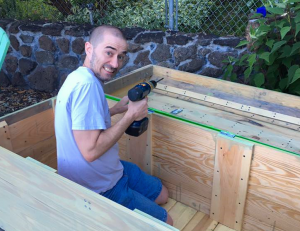5 MS Patients Across US Talk About How Ocrevus Has Changed Their Lives
Written by |

Lorraine Lee, who has PPMS, on a visit to Thailand. (Photo courtesy of Lorraine Lee)
It’s been a little over a year since U.S. regulators approved Genentech’s Ocrevus (ocrelizumab) as the first treatment for both relapsing and progressive forms of multiple sclerosis (MS) — a disabling neurological disease now believed to affect nearly one million Americans.
While the jury’s still out regarding the therapy’s long-term effectiveness and safety, five MS patients we spoke to across the United States say Ocrevus — an intravenous infusion therapy that carries a retail price of $65,000 a year — has made a dramatic difference in their daily lives.
Here are their stories:
Lorraine Lee
Lorraine Lee is a registered nurse in Austin, Texas. She first spoke to MS News Today a year ago, shortly after receiving Ocrevus for the first time, and two and a half years after first being diagnosed with primary progressive multiple sclerosis. PPMS affects about 15 percent of all MS patients.
Since then, Lee’s had two more Ocrevus infusions six months apart, each one lasting about four hours. All treatments have been covered by her husband’s insurance plan.
“I still see small improvements,” she said. “It’s not as fast as I’d like it to be, but the fact there’s been no more regression is meeting the goal of Ocrevus, and I’m also starting to see small improvements in my mobility.”

Lorraine Lee, who has PPMS, on a visit to Taiwan earlier this year. (Photo courtesy Lorraine Lee)
Lee has already been to Taiwan twice in the past year — accompanying her husband on business trips — and her MS hasn’t seemed to slow her down.
“The first time, I took my walker and used it extensively. The second time I went, I took my walker and never used it,” said Lee, who now reviews medical records for her state’s government.
“When I first wake up in the morning, I feel really stiff and I use my cane. But then I put it to one side and do all my things in the kitchen without it,” she said. “Then I load everything into the walker, which has a basket on it, and load that into my car. I use my walker for toting things back and forth.”
Lee, who now walks up to a mile a day, said she’d rather sit for an Ocrevus infusion twice a year than take any other kind of medicine. “Give me my infusion and get it over with. I’ve never had any side effects, and last time I didn’t even get sleepy,” she said.
“If you’re really in tune with your body, you notice little improvements,” added Lee, who maintains a strictly dairy-free, gluten-free diet, and eats lots of vegetables and protein. “For example, I had gotten to the point, before Ocrevus, where my husband had to fill out all my paperwork because I could not write. And now I’m independent with my writing again.”
Charles Dick
Before he was diagnosed with relapsing-remitting multiple sclerosis (RRMS) some 15 years ago, Charles Dick was a promising graduate student specializing in agricultural genetics. After his diagnosis, he transferred to pharmacy, hoping to develop a cure for MS.
But his condition worsened, and Dick was forced to drop out of school altogether.
“Since my diagnosis, I had been on Copaxone. I also take vitamin D and other supplements, which also help me quite a lot,” he told us by phone from Spokane, Washington.

Charles Dick of Spokane, Washington, building a wood storage chest. He has RRMS. (Photo courtesy of Charles Dick)
Now 46, Dick said that since his diagnosis he’s occasionally noticed some unsteadiness in his legs, as well as forgetfulness, difficulty concentrating, numbness, and a lack of energy, among other symptoms. After several years on Copaxone, his condition again took a turn for the worse.
“Luckily, Ocrevus had just been approved, so I talked to my doctor about switching,” he said. “Since then, my condition seems far more stable.”
After the first two infusions, he felt a slight tingle in the back of his throat. But Ocrevus, he said, has definitely made him feel more intact.
“My symptoms are gradually getting less severe since I’ve been on it,” Dick said, adding he’s “been doing very well on Ocrevus and have no complaints at all,” excepting that “it’s still not a cure …the gold standard we’re looking for.”
“What I want,” Dick said, “is something to take once — and then no longer have MS.”
Roberta Sloniker
Roberta Sloniker, 74, was diagnosed with PPMS at age 50. She used to wake up at 5 a.m. and walk four miles every day. That helped Sloniker lose 75 pounds — but it didn’t stop her disease from slowly crippling her, until she needed a walker just to get around the house and a wheelchair to move more than 20 feet.
“I’m obviously not very mobile. The whole right side of my body is extremely weak,” said Sloniker, who lives in the Oregon coastal town of Brookings, just north of the California state line. “My right hand is curling, and I can’t straighten it out, so I have very little use of it.”
After a first Ocrevus infusion in November, she said she started feeling better immediately. She called it the first medication in more than 15 years, other than baclofen, that helped to stop cramps.
“I can stay up and do more things, but I just feel better all over. People are telling me they can see that,” she said, explaining she can now be on her feet for up to half an hour, as opposed to 10 minutes at most before Ocrevus. “In fact, I felt really good after the infusion because they give you a steroid, and that really took all the aches and pains away for about two weeks.”
Sloniker will return to a clinic in nearby Medford, Oregon, on May 3 for her next Ocrevus treatment. “I’m excited to get the next infusion,” she said.
Cheryl Sickler
Cheryl Sickler of Deltona, Florida, was diagnosed with optical neuritis in 1996. She also suffered from dizziness, loss of balance and frequent falls. She finally received an MS diagnosis in December 2002, and by 2005, her health was deteriorating rapidly.
“They did an MRI and found over 40 active lesions on my brain,” said the Cincinnati native, who worked on hospital computer systems until MS forced her to quit. “My neurologist told me I’d have full-blown dementia within two years if I didn’t do anything.”
Sickler’s neurologist prescribed a steroid treatment that required her to take 16 pills every six hours, or 192 pills over a three-day period.

Cheryl Sickler, right, with her daughters Geena, at left, and Claudia. (Photo courtesy of Cheryl Sickler)
“I did that once every four months, but it didn’t help. I had bad side effects and ended up getting a couple rounds of chemotherapy,” she said. “I did that twice and went on a completely raw diet with herbs. After two years, the lesions were finally inactive, but still, none of the drugs were working.”
Sickler tried Rebif, Copaxone and Tysabri, all to no avail. She could no longer hold down her job at UF Health Shands Hospital in Gainesville, and in early 2010 filed for disability.
“I wasn’t able to do much of anything. I was using a walker and a cane, and if I went anywhere at all, I’d have to be pushed around in a wheelchair,” she said.
But things started turning around for Sickler, now 52, after her first infusion of Ocrevus in June 2017, at a clinic in nearby Daytona Beach. A second infusion was given in December.
“It wasn’t long after the first infusion that I didn’t need the wheelchair. Then I got rid of my walker, and maybe three weeks after the second infusion, I was barely using a cane at all, and I haven’t used one for about three months now.”
She added: “I’m just amazed. Ocrevus has been remarkable. Even my cognitive abilities are getting a little better.”
Sickler will receive her third infusion in June. Thanks to her Medicare coverage, she said her only out-of-pocket expense is a $50 per infusion co-pay.
Steven Slobodzian
A former executive for Pepsi-Cola, Steven Slobodzian of Overland Park, Kansas, took early retirement at the age of 58 — one year before he started having health issues.
In 2011, Slobodzian was diagnosed with PPMS, and within a year the disease had progressed so quickly that he soon found himself in a wheelchair. Slobodzian’s doctor put him on Solu-Medrol (methylprednisolone), a steroid to reduce the pain in his legs. But that required his wife to drive him five days in a row, every three months, to Kansas University in nearby Kansas City for his Solu-Medrol infusions.
Slobodzian, now 65, has been confined to a wheelchair for the last six years. When he found out about Ocrevus, he told his doctor he wanted to hold off on Solu-Medrol to give the new therapy a chance.
“Ocrevus basically took care of the pain, but also gives me renewed strength in my legs, like Solu-Medrol used to,” he said, adding that he hasn’t had any side effects from his first infusion.
“I do feel better in general. I seem to have more energy, but not sure if it’s because of Ocrevus or the biotin I’ve been taking,” Slobodzian said. “In all, it’s been a pretty positive experience, and I’m just super glad somebody came out with a drug for PPMS.
“I thought we were the forgotten people.”





